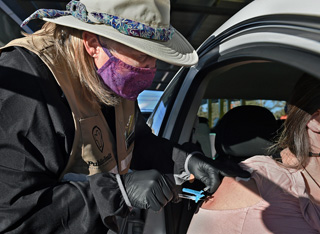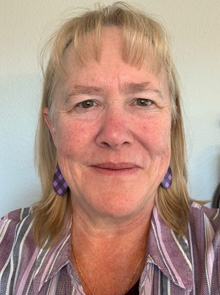Teri shot

Photo by Andy Barron
Dr. Teri Ann Oursler is translating her years of experience vaccinating dogs, cats, horses and cattle to administering the COVID-19 vaccine in people.
Standing in a local drug store recently, watching the pharmacists scurry around filling the day's prescriptions, I wondered how they would ever have the time to administer COVID-19 vaccines in the same way they give flu vaccines.
A few weeks earlier, I'd read an article published by the VIN News Service on how veterinarians in Manitoba, Canada, have been invited to help vaccinate people. It got me thinking about whether I could help with the vaccine rollout. I closely followed a message-board conversation on the Veterinary Information Network, an online community for the profession, as my colleagues discussed the article. Our thoughts ranged all over the map:
Where do I sign up?
How many vaccinators can they need, with pharmacists and nurses already vaccinating?
I can't poke a person!
Can I give them cheese or peanut butter as I vaccinate?
My mind also reflected back to the Veterinarian's Oath I took upon graduating from Colorado State University in 1993:
Being admitted to the profession of veterinary medicine, I solemnly swear to use my scientific knowledge and skills for the benefit of society through the protection of animal health and welfare, the prevention and relief of animal suffering, the conservation of animal resources, the promotion of public health and the advancement of medical knowledge.
 I thought about that in the context of veterinarians and non-veterinarians alike throughout the world feeling helpless in the face of COVID-19, and all that has gone on for the past 11 months. Most of the general public cannot help the nurses and doctors treat patients. Sure, we can stay home, wash our hands and wear a mask, but it has made a lot of us feel impotent in the face of this pandemic. I kept thinking about the promotion of public health.
I thought about that in the context of veterinarians and non-veterinarians alike throughout the world feeling helpless in the face of COVID-19, and all that has gone on for the past 11 months. Most of the general public cannot help the nurses and doctors treat patients. Sure, we can stay home, wash our hands and wear a mask, but it has made a lot of us feel impotent in the face of this pandemic. I kept thinking about the promotion of public health.
I decided to offer to volunteer to help vaccinate people against COVID-19. I feel like I have to do something to help, and after 19 years of practice, giving thousands of vaccinations to dogs, cats, horses and cattle, I figured the skill ought to be transferable. I am under 65 and in good health. The only comorbidity I have is being overweight, but I do not have diabetes or hypertension. No one relies on me for caretaking but the cats, and my husband is quite capable of taking care of them, the dog and himself.
Also, I recently relocated to Nevada from Wyoming and, as I work full-time for VIN, I no longer practice clinical veterinary medicine, so no clients and sick pets rely on me. It felt right.
The next big question was where to begin. I emailed the county public health department. They sent me a link where I could sign up with the Medical Reserve Corps (MRC) of Nevada, which is part of a national program to provide volunteer health care workers in times of emergencies.
As I filled out the multiple forms, all I could think was that it might take a miracle to get it all done before COVID-19 was over. How wrong I was! Within two days, I had been accepted to the MRC and assigned to a COVID pod. Go, Nevada MRC! They quickly had me scheduled for eight four-hour shifts over three weeks.
As the day of my first shift drew nigh, I was nervous. The drive-through vaccination clinic is held at the Reno Livestock Center, and it just seemed apropos for a veterinarian to be there! We are still at tier 1 of people to be vaccinated, and this group was all teachers. The nurse coordinator from my county paired me with two retired nurses for training. These women were wonderful: patience personified. They showed me how to vaccinate a person, how to handle the safety syringes used in human medicine and how to fill out the paperwork.
I was the only veterinarian there.
I had to be shown how to give a vaccination to a person. For one thing, in people, this vaccination goes into the muscle; in pets, vaccinations are given subcutaneously (under the skin). The COVID-19 vaccination goes in the deltoid (shoulder) muscle, which is not well-defined in the majority of people. All I knew about deltoids is that I was in love with Tony Danza's in the 1980s!
I learned to locate the right place by going to the end of the shoulder bone, then measure three fingers down to find the spot. Some people had to take their shirts off, which was kind of hard in their cars. Veterinarians are not used to their patients disrobing, but it was fine with me. Plus — and this was a big deal — with people, you have to check their weight to get the right needle length. You need a longer needle for a muscular man than for a thin woman. Also, veterinarians do not swab the skin first or use Band-Aids afterward.
Nevada MRC has pharmacists draw up the vaccine, so that was one thing I did not have to learn. It turns out that drawing up these vaccines, especially Pfizer's, is more technical than the standard veterinary vaccines I had cut my teeth on.
I worked alternately with Nurse Becky and Nurse Holly to watch how they did things. As it came time for me to give my first dose with them looking on, I was shaking with nerves. It took me several tries to remember to take everything out with me. Finally, Nurse Becky said, "Remember, you are picking up five things: alcohol swab, gauze, bandage, vaccine, vaccination card." Duh, I can count to five! But in veterinary medicine, we do not use alcohol swabs, gauze or bandages, and my staff filled out the vaccination card, so those are all extra steps for me.
Teri

Photo by Dr. Teri Ann Oursler
Like so many people, Dr. Teri Ann Oursler has felt helpless against the pandemic. By volunteering as a COVID-19 vaccinator, she feels useful rather than powerless.
After watching me a couple of times, she also suggested that I could use some bedside manners and that I was allowed to talk to these people. She did not out-and-out say, "They are not cattle in a chute," but that is how I interpreted it.
She said she knew I was nervous, that the patients were nervous too, and nervous patients are not relaxed. I did not know what to say to patients other than, "Hi, how are you? Possible side effects include … and then you wait 15 minutes over there."
It took me about 10 vaccinations to get over being nervous and to remember to bring a Band-Aid. I finally settled on a conversation starter:
"The best part of today's vaccine is that you are being vaccinated by a veterinarian, so when we are done, I will give you a treat and scratch behind your ears." This made people laugh, which made them relax. I got some great responses: One lady said it would feel good after wearing all of these masks. One gentleman said he would be sure to thump his leg in appreciation.
I met one young person who shares my birthday (although the person was much younger than me). Quite a few people came through with their dogs in their cars. I am still a dog magnet and I enjoyed petting their dogs. Sam the Lab really wanted me to give him attention. "Forget my owner!" he told me. You have to be careful, though, as one nurse had almost been bitten the day before by a dog that did not want the owner hurt.
Being able to make people laugh is the key to doing this. These are COVID-weary people working jobs that put them at risk. They have also been exposed to incorrect information touted by the anti-vaccination movement, so they were worried. Who isn't?
I did not feel at risk because it was outdoors, everybody was masked in their car, I was masked and I changed gloves between each person. My guesstimate is that I vaccinated approximately 75 to 100 people each shift.
This vaccination effort is huge and requires a lot of people power. At my site, people evaluated the patients as they came in the gate, verified their appointment, directed traffic to the vaccination pods and then to the parking lot to wait for 15 to 30 minutes in case of an allergic reaction. My traffic directors kept me from getting hit, as I was busy counting to five items rather than watching cars.
We had retired nurses and pharmacists, as well as nurses and pharmacists who were there on their day off. We had staff from the Washoe County Public Health District who organized and directed us so we were not standing around wondering what we were supposed to be doing. It was really professional.
At the end of my first shift, I was vaccinated. Good things happen when you volunteer!
Later this week, I have my third vaccinator shift and I am looking forward to it. I am enjoying feeling useful rather than impotent in the face of the pandemic.
About the author: Dr. Teri Ann Oursler is a graduate of Colorado State University, where she earned her DVM. She is retired from practice after working 19 years in small animal medicine in Powell, Wyoming. Now she works for the Veterinary Information Network, helping veterinarians find information for their cases. She resides with her husband, one dog and two cats in northern Nevada. She misses her Wyoming friends and mountains.